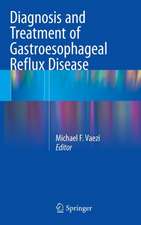Biliary Disease: From Science to Clinic
Editat de Gideon Hirschfield, David Adams, Evaggelia Liaskouen Limba Engleză Hardback – 6 mar 2017
| Toate formatele și edițiile | Preț | Express |
|---|---|---|
| Paperback (1) | 554.46 lei 38-44 zile | |
| Springer International Publishing – 20 iul 2018 | 554.46 lei 38-44 zile | |
| Hardback (1) | 731.07 lei 3-5 săpt. | |
| Springer International Publishing – 6 mar 2017 | 731.07 lei 3-5 săpt. |
Preț: 731.07 lei
Preț vechi: 769.55 lei
-5% Nou
Puncte Express: 1097
Preț estimativ în valută:
139.88€ • 146.07$ • 115.52£
139.88€ • 146.07$ • 115.52£
Carte disponibilă
Livrare economică 26 martie-09 aprilie
Preluare comenzi: 021 569.72.76
Specificații
ISBN-13: 9783319501666
ISBN-10: 3319501666
Pagini: 286
Ilustrații: VIII, 264 p. 28 illus., 23 illus. in color.
Dimensiuni: 155 x 235 mm
Greutate: 0.8 kg
Ediția:1st ed. 2017
Editura: Springer International Publishing
Colecția Springer
Locul publicării:Cham, Switzerland
ISBN-10: 3319501666
Pagini: 286
Ilustrații: VIII, 264 p. 28 illus., 23 illus. in color.
Dimensiuni: 155 x 235 mm
Greutate: 0.8 kg
Ediția:1st ed. 2017
Editura: Springer International Publishing
Colecția Springer
Locul publicării:Cham, Switzerland
Cuprins
The clinical burden of biliary disease- a global perspective.- The healthy biliary tree- cellular and immunobiology.- Bile acid signalling and the current understanding of cholestasis: new opportunities for treatments?.- Animal models of biliary disease- current approaches and limitations.- The microbiome and human disease- a new organ of interest in biliary disease?.- Progressive familial intrahepatic cholestatic syndromes- genetic insights into biliary transporter function.- Biliary atresia- from pathology to treatment.- Drug induced cholestasis: mechanisms and importance.- Primary biliary cirrhosis- it’s science and practice.- Primary sclerosing cholangitis- current concepts in biology and strategies for new therapy.- Cholangiocarcinoma- evaluation of risk and new treatment paradigms.- Gallstone disease in the 21st century: practice and controversies.- Autoimmune sclerosing cholangitis/IgG4 cholangiopathy- new diseases?.- Conclusions and future opportunities.
Recenzii
“This compact and readable book has a broad ambition to cover the basic science, clinical practice, future therapies and advances in this wide field. … The chapters are well chosen to cover the speciality. The text is well organized and easy to follow and search with paragraph headings. … Photos and graphics are plentiful and colourful. … This will prove to be a very useful textbook and reference for clinicians and other professionals working in the field of biliary disease.” (James Rink, British Journal of Hospital Medicine, Vol. 78 (11), November, 2017)
Notă biografică
David H. Adams, MD, FRCP, FMedSci is the Pro-Vice-Chancellor, Head of College of Medical and Dental Sciences and Dean of Medicine at the University of Birmingham, UK, as well as Professor of Hepatology and Honorary Consultant Hepatologist. He is an international leader in inflammatory liver disease and immune mechanisms of liver injury and has been at the forefront of developments in liver immunology over the last 20 years. He has published more than 250 papers and has attracted significant grant income nationally and internationally. His clinical interests are transplant hepatology and autoimmune liver disease. He has played major leadership roles nationally and internationally. He has a particular interest in clinical academic careers and chairs the AMS Mentoring working group and has been a member of fellowship panels at MRC, Wellcome Trust and Core and INSERM (France). Laboratory research interests are focused on mechanisms of immune-mediated liverdisease. He was made a Fellow of the Academy of Medical Sciences in 2000 and an NIHR senior investigator in 2013. He has a long-standing interest in understanding how leukocyte-endothelial interactions regulate the development and persistence of chronic inflammation and fibrosis in liver disease and how specific micro-environmental signals determine the positioning, activation and survival of effector cells within the liver. Based on this knowledge his laboratory demonstrated the role of specific adhesion molecules and chemokines in liver disease and helped to define the function of novel molecules including vascular adhesion protein-1. His laboratory are now using their knowledge of the molecular mechanisms that regulate leukocyte trafficking to the liver to develop immune and cellular therapies for liver disease through the facilities provided by the Birmingham NIHR Liver BRU.
Gideon M. Hirschfield, MA, MB, BChir, FRCP, PhD is a Professor and Honorary Consultant Transplant Hepatologist at the University of Birmingham, UK. He is committed to discovery and translational science in immune-mediated liver disease and his research goals focus on identification and implementation of effective, personalised therapies for patients with immune-mediated liver diseases. Dr. Hirschfield graduated from Cambridge, and trained academically/clinically at UCL/Cambridge, before moving to Toronto. He was recruited in 2012 to develop the Birmingham autoimmune liver programme, since when he has exploited the unique clinical and scientific environment, establishing himself as a world leader and key opinion former. He has published over 145 papers and his work, with colleagues and collaborators include: a) discovery of novel genetic risk factors for PBC; b) application of immune based screening technology to understand immune mediated liver disease; c) development of internationally applied stratifiers of clinical outcome in autoimmune liver disease; d) design, conduct and reporting of early phase clinical trials in immune-mediated liver disease spanning Industry and Academic lead studies; e) leadership in NIHR/MRC funded national disease platforms (UK-PBC, UK-PSC, UK-Autoimmune; Training lead NIHR-Rare Disease TRC) and patient (PBC Foundation, PSC Support, AIH support) engagement.
Evaggelia Liaskou, BSc, PhD is a senior post-doctoral research fellow at the Centre for Liver Research and NIHR Biomedical Research Unit, Institute of Immunology and Immunotherapy at the University of Birmingham, UK. Her area of interest is in understanding the nature and function of lymphocytic infiltration in autoimmune liver disease, and she is the first author on a number of seminal papers in the field. Dr. Liaskou earned a BSc in Molecular Biology and Genetics at the University of Thrace, Greece, and a PhD degree in liver immunology at the University of Birmingham. As a Marie Curie Early Stage Career PhD fellow she also worked at the University of Turku in Finland for six months. Since 2012 she has been working with Dr Hirschfield with research interests on the immunobiology of autoimmune liver diseases. As a post-doctoral research fellow she has been awarded a Sheila Sherlock Short-Term Training Fellowship, which allowed her to spend three months at the Norwegian PSC Centre in Oslo, Norway. PSC Partners Seeking a Cure and Wellcome Trust ISSF are some of the other funders that have supported her research, in addition to salary support from NIHR and MRC (UK-PBC).
Gideon M. Hirschfield, MA, MB, BChir, FRCP, PhD is a Professor and Honorary Consultant Transplant Hepatologist at the University of Birmingham, UK. He is committed to discovery and translational science in immune-mediated liver disease and his research goals focus on identification and implementation of effective, personalised therapies for patients with immune-mediated liver diseases. Dr. Hirschfield graduated from Cambridge, and trained academically/clinically at UCL/Cambridge, before moving to Toronto. He was recruited in 2012 to develop the Birmingham autoimmune liver programme, since when he has exploited the unique clinical and scientific environment, establishing himself as a world leader and key opinion former. He has published over 145 papers and his work, with colleagues and collaborators include: a) discovery of novel genetic risk factors for PBC; b) application of immune based screening technology to understand immune mediated liver disease; c) development of internationally applied stratifiers of clinical outcome in autoimmune liver disease; d) design, conduct and reporting of early phase clinical trials in immune-mediated liver disease spanning Industry and Academic lead studies; e) leadership in NIHR/MRC funded national disease platforms (UK-PBC, UK-PSC, UK-Autoimmune; Training lead NIHR-Rare Disease TRC) and patient (PBC Foundation, PSC Support, AIH support) engagement.
Evaggelia Liaskou, BSc, PhD is a senior post-doctoral research fellow at the Centre for Liver Research and NIHR Biomedical Research Unit, Institute of Immunology and Immunotherapy at the University of Birmingham, UK. Her area of interest is in understanding the nature and function of lymphocytic infiltration in autoimmune liver disease, and she is the first author on a number of seminal papers in the field. Dr. Liaskou earned a BSc in Molecular Biology and Genetics at the University of Thrace, Greece, and a PhD degree in liver immunology at the University of Birmingham. As a Marie Curie Early Stage Career PhD fellow she also worked at the University of Turku in Finland for six months. Since 2012 she has been working with Dr Hirschfield with research interests on the immunobiology of autoimmune liver diseases. As a post-doctoral research fellow she has been awarded a Sheila Sherlock Short-Term Training Fellowship, which allowed her to spend three months at the Norwegian PSC Centre in Oslo, Norway. PSC Partners Seeking a Cure and Wellcome Trust ISSF are some of the other funders that have supported her research, in addition to salary support from NIHR and MRC (UK-PBC).
Textul de pe ultima copertă
This book addresses the current understanding of the diagnosis and management of biliary disease across all ages, with emphasis on how the latest advances in clinical science may be integrated into current and future therapies. The coverage is wide ranging, encompassing congenital and acquired conditions including cholestatic syndromes, biliary atresia, drug-induced cholestasis, primary biliary cholangitis/cirrhosis, primary sclerosing cholangitis, cholangiocarcinoma, gallstone disease, and autoimmune sclerosing cholangitis. With contributions from basic and clinical scientists, the relevance of state-of-the-art mechanistic biology to diagnosis, treatment, and future opportunities for drug design is clearly explained. The balance between science and clinical practice will ensure that this book makes a lasting contribution to the field. A broad readership will find the book easy to access and a rich source of information on current best practice and evolving management strategies.
Caracteristici
Presents concise, up-to-date information on diagnosis and management of biliary disease Explores in detail the relationship between science and clinical practice Covers the entire spectrum across adult and pediatric practice













